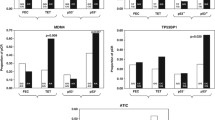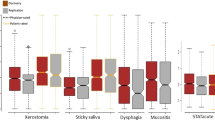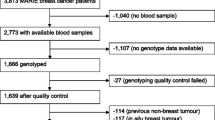Abstract
Background and purpose
The aim of this study was to determine the impact of functional single nucleotide polymorphism (SNP) pathways involved in the ROS pathway, DNA repair, or TGFB1 signaling on acute or late normal toxicity as well as individual radiosensitivity.
Materials and methods
Patients receiving breast-conserving surgery and radiotherapy were examined either for erythema (n = 83), fibrosis (n = 123), or individual radiosensitivity (n = 123). The 17 SNPs analyzed are involved in the ROS pathway (GSTP1, SOD2, NQO1, NOS3, XDH), DNA repair (XRCC1, XRCC3, XRCC6, ERCC2, LIG4, ATM) or TGFB signaling (SKIL, EP300, APC, AXIN1, TGFB1). Associations with biological and clinical endpoints were studied for single SNPs but especially for combinations of SNPs assuming that a SNP is either beneficial or deleterious and needs to be weighted.
Results
With one exception, no significant association was seen between a single SNP and the three endpoints studied. No significant associations were also observed when applying a multi-SNP model assuming that each SNP was deleterious. In contrast, significant associations were obtained when SNPs were suggested to be either beneficial or deleterious. These associations increased, when each SNP was weighted individually. Detailed analysis revealed that both erythema and individual radiosensitivity especially depend on SNPs affecting DNA repair and TGFB1 signaling, while SNPs in ROS pathway were of minor importance.
Conclusion
Functional pathways of SNPs may be used to form a risk score allowing to predict acute and late radiation-induced toxicity but also to unravel the underlying biological mechanisms.
Zusammenfassung
Hintergrund und Ziel
Für ein SNP-Netzwerk („single nucleotide polymorphism“, Einzelnukleotidpolymorphismus), welches im ROS-Signalweg, an der DNA-Reparatur und im TGFB1-Signalweg involviert ist, sollen die Bedeutung für die akute und späte Toxizität sowie die individuelle Strahlenempfindlichkeit bestimmt werden.
Material und Methoden
Nach Strahlentherapie wurden Brustkrebspatientinnen entweder hinsichtlich des Erythems (n = 83), einer Fibrose (n = 123) oder der individuellen Strahlenempfindlichkeit (n = 123) untersucht. Die 17 untersuchten SNPs sind entweder am ROS-Pathway (GSTP1, SOD2, NQO1, NOS3, XDH), bei der DNA-Reparatur (XRCC1, XRCC3, XRCC6, ERCC2, LIG4, ATM) oder dem TGFB Signalling (SKIL, EP300, APC, AXIN1, TGFB1) beteiligt. Die Assoziation mit biologischen und klinischen Endpunkten wurde für einzelne, aber insbesondere für Kombinationen von SNPs untersucht, wobei angenommen wurde, dass ein SNPs sowohl von Vorteil als auch von Nachteil sein kann und auch gewichtet werden sollte.
Ergebnisse
Mit einer Ausnahme wurde für einen einzelnen SNP keine signifikante Assoziation identifiziert. Ebenfalls keine signifikante Assoziation wurde gefunden, wenn alle SNPs in einem Wert zusammengefasst werden, unter der Annahme, dass ein SNP immer nachteilig ist. Im Gegensatz dazu ergeben sich signifikante Assoziationen, wenn davon ausgegangen wird, dass ein SNP entweder nachteil- oder vorteilhaft sein kann. Diese Assoziationen werden noch stärker, wenn die SNPs individuell gewichtet werden. Eine detaillierte Analyse des Netzwerks ergibt, dass das Erythem und die individuelle Strahlenempfindlichkeit insbesondere durch SNPs in der DNA-Reparatur und dem TGFB1-Signalweg bestimmt werden, während SNPs im ROS-Signalweg ohne große Bedeutung sind.
Schlussfolgerung
Funktionale SNP-Netzwerke können genutzt werden, um einen Risikoscore zu bilden, der es erlaubt das Risiko für akute und späte Toxizität vorherzusagen und die zugrundeliegenden Mechanismen aufzuklären.


Similar content being viewed by others
References
Alsbeih G, Al-Harbi N, Al-Hadyan K et al (2010) Association between normal tissue complications after radiotherapy and polymorphic variations in TGFB1 and XRCC1 genes. Radiat Res 173:505–511
Alsner J, Andreassen CN, Overgaard J (2008) Genetic markers for prediction of normal tissue toxicity after radiotherapy. Semin Radiat Oncol 18:126–135
Andreassen CN, Alsner J, Overgaard J (2002) Does variability in normal tissue reactions after radiotherapy have a genetic basis–where and how to look for it?. Radiother Oncol 64:131–140
Andreassen CN, Alsner J, Overgaard M et al (2003) Prediction of normal tissue radiosensitivity from polymorphisms in candidate genes. Radiother Oncol 69:127–35
Angele S, Romestaing P, Moullan N et al (2003) ATM haplotypes and cellular response to DNA damage: association with breast cancer risk and clinical radiosensitivity. Cancer Res 63:8717–8725
Azria D, Ozsahin M, Kramar A et al (2008) Single nucleotide polymorphisms, apoptosis, and the development of severe late adverse effects after radiotherapy. Clin Cancer Res 14:6284–6288
Azria D, Betz M, Bourgier C et al (2012) Identifying patients at risk for late radiation-induced toxicity. Crit Rev Oncol Hematol 84(Suppl 1):e35–e41.
Barnett GC, Coles CE, Elliott RM et al (2012) Independent validation of genes and polymorphisms reported to be associated with radiation toxicity: a prospective analysis study. Lancet Oncol 13:65–77
Barnett GC, Elliott RM, Alsner J et al (2012) Individual patient data meta-analysis shows no association between the SNP rs1800469 in TGFB and late radiotherapy toxicity. Radiother Oncol 105:289–295
Borgmann K, Hoeller U, Nowack S et al (2008) Individual radiosensitivity measured with lymphocytes may predict the risk of acute reaction after radiotherapy. Int J Radiat Oncol Biol Phys 71:256–264
Cesaretti JA, Stock RG, Lehrer S et al (2005) ATM sequence variants are predictive of adverse radiotherapy response among patients treated for prostate cancer. Int J Radiat Oncol Biol Phys 61:196–202
Castiglia D, Bernardini S, Alvino E et al (2008) Concomitant activation of Wnt pathway and loss of mismatch repair function in human melanoma. Genes Chromosomes Cancer 47:614–624
Chang-Claude J, Popanda O, Tan XL et al (2005) Association between polymorphisms in the DNA repair genes, XRCC1, APE1, and XPD and acute side effects of radiotherapy in breast cancer patients. Clin Cancer Res 11:4802–4809
Chang-Claude J, Ambrosone CB, Lilla C et al (2009) Genetic polymorphisms in DNA repair and damage response genes and late normal tissue complications of radiotherapy for breast cancer. Br J Cancer 100:1680–1686
De Ruyck K, Van Eijkeren M, Claes K et al (2006) TGFbeta1 polymorphisms and late clinical radiosensitivity in patients treated for gynecologic tumors. Int J Radiat Oncol Biol Phys 65:1240–1248
Dikomey E (2013) Predictive marker for acute normal tissue toxity in radiotherapy of non-small cell lung cancer. Strahlenther Onkol 189:806–808
Dikomey E, Borgmann K, Brammer I et al (2003) Molecular mechanisms of individual radiosensitivity studied in normal diploid human fibroblasts. Toxicology 193:125–135
Dikomey E, Dahm-Daphi J, Distel L (2012) Prediction of the reaction of normal tissue and tumor cells to radiotherapy. Strahlenther Onkol 188(Suppl 3):304–307
Ghazali N, Shaw RJ, Rogers SN et al (2012) Genomic determinants of normal tissue toxicity after radiotherapy for head and neck malignancy: a systematic review. Oral Oncol 48:1090–1100
Ho AY, Fan G, Atencio DP et al (2007) Possession of ATM sequence variants as predictor for late normal tissue responses in breast cancer patients treated with radiotherapy. Int J Radiat Oncol Biol Phys 69:677–684
Hoeller U, Borgmann K, Bonacker M et al (2003) Individual radiosensitivity measured with lymphocytes may be used to predict the risk of fibrosis after radiotherapy for breast cancer. Radiother Oncol 69:137–144
Kasten-Pisula U, Tastan H, Dikomey E (2005) Huge differences in cellular radiosensitivity due to only very small variations in double-strand break repair capacity. Int J Radiat Biol 81:409–419
Kodigepalli KM, Dutta PS, Bauckman KA et al (2013) SnoN/SkiL expression is modulated via arsenic trioxide-induced activation of the PI3K/AKT pathway in ovarian cancer cells. FEBS Lett 587:5–516
Kuptsova N, Chang-Claude J, Kropp S et al (2008) Genetic predictors of long-term toxicities after radiation therapy for breast cancer. Int J Cancer 122:1333–13339
Langsenlehner T, Thurner EM, Renner W et al (2014) Association of genetic variants in VEGF-A with clinical recurrence in prostate cancer patients treated with definitive radiotherapy. Strahlenther Onkol 190:364–369
Mangoni M, Bisanzi S, Carozzi F et al (2011) Association between genetic polymorphisms in the XRCC1, XRCC3, XPD, GSTM1, GSTT1, MSH2, MLH1, MSH3, and MGMT genes and radiosensitivity in breast cancer patients. Int J Radiat Oncol Biol Phys 81:52–58
Moullan N, Cox DG, Angele S et al (2003) Polymorphisms in the DNA repair gene XRCC1, breast cancer risk, and response to radiotherapy. Cancer Epidemiol Biomarkers Prev 12:1168–1174
Raabe A, Derda K, Reuther S et al (2012) Association of single nucleotide polymorphisms in the genes ATM, GSTP1, SOD2, TGFB1, XPD and XRCC1 with risk of severe erythema after breast conserving radiotherapy. Radiat Oncol 7:65
Reuther S, Metzke E, Bonin M et al (2013) No effect of the transforming growth factor beta1 promoter polymorphism C-509T on TGFB1 gene expression, protein secretion, or cellular radiosensitivity. Int J Radiat Oncol Biol Phys 85:460–465
Suga T, Ishikawa A, Kohda M et al (2007) Haplotype-based analysis of genes associated with risk of adverse skin reactions after radiotherapy in breast cancer patients. Int J Radiat Oncol Biol Phys 69:685–693
Thurner EM, Krenn-Pilko S, Langsenlehner U et al (2014) Association of genetic variants in apoptosis genes FAS and FASL with radiation-induced late toxicity after prostate cancer radiotherapy. Strahlenther Onkol 190:304–309
Turnbull CL, Bacon AL, Dunlop MG et al (2012) In vitro stability of APC gene sequences and the influence of DNA repair status. Mutagenesis 27:233–238
Van Den Broeck A, Nissou D, Brambilla E et al (2012) Activation of a Tip60/E2F1/ERCC1 network in human lung adenocarcinoma cells exposed to cisplatin. Carcinogenesis 33:320–325
Wellek S, Goddard KA, Ziegler A (2010) A confidence-limit-based approach to the assessment of Hardy-Weinberg equilibrium. Biom J 52:253–570
West CM, Davidson SE, Elyan SA et al (2001) Lymphocyte radiosensitivity is a significant prognostic factor for morbidity in carcinoma of the cervix. Int J Radiat Oncol Biol Phys 51:10–15
West C, Rosenstein BS, Alsner J et al (2010) Establishment of a radiogenomics consortium. Int J Radiat Oncol Biol Phys 76:1295–1296
Yang M, Zhang L, Bi N et al (2011) Association of P53 and ATM polymorphisms with risk of radiation-induced pneumonitis in lung cancer patients treated with radiotherapy. Int J Radiat Oncol Biol Phys 79:1402–1407
Zhang Q, Irvin MR, Arnett DK et al (2011) A data-driven method for identifying rare variants with heterogeneous trait effects. Genet Epidemiol 35:679–685
Zschenker O, Raabe A, Boeckelmann IK et al (2010) Association of single nucleotide polymorphisms in ATM, GSTP1, SOD2, TGFB1, XPD and XRCC1 with clinical and cellular radiosensitivity. Radiother Oncol 97:26–32
Compliance with ethical guidelines
Acknowledgments
The authors thank Ms. Maria Omniczynski for the excellent technical assistance. This project was supported by the Deutsche Bundesministerien für Umwelt und Reaktorsicherheit (BMU, grant no. StrSch4460) as well as Bildung und Forschung (BMBFgrant no. 02NUK005B).
Conflict of interest
Reuther, S. Szymzcak, A. Raabe, K. Borgmann, A. Ziegler, C. Petersen, E. Dikmey and U. Hoeller state that there are no conflicts of interest.
Author information
Authors and Affiliations
Corresponding author
Additional information
Sebastian Reuther and Silke Szymczak contributed equally to this work.
Rights and permissions
About this article
Cite this article
Reuther, S., Szymczak, S., Raabe, A. et al. Association between SNPs in defined functional pathways and risk of early or late toxicity as well as individual radiosensitivity. Strahlenther Onkol 191, 59–66 (2015). https://doi.org/10.1007/s00066-014-0741-y
Received:
Accepted:
Published:
Issue Date:
DOI: https://doi.org/10.1007/s00066-014-0741-y




